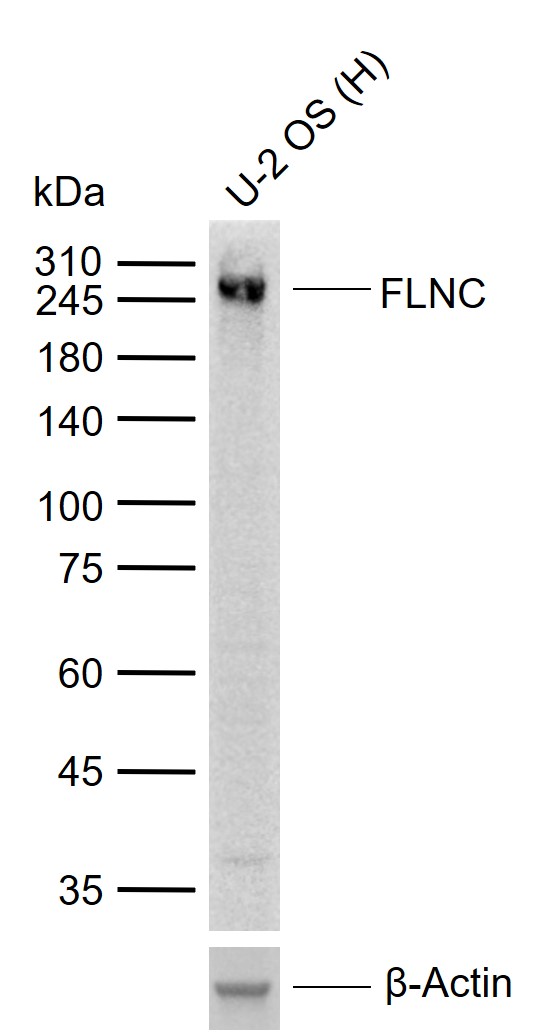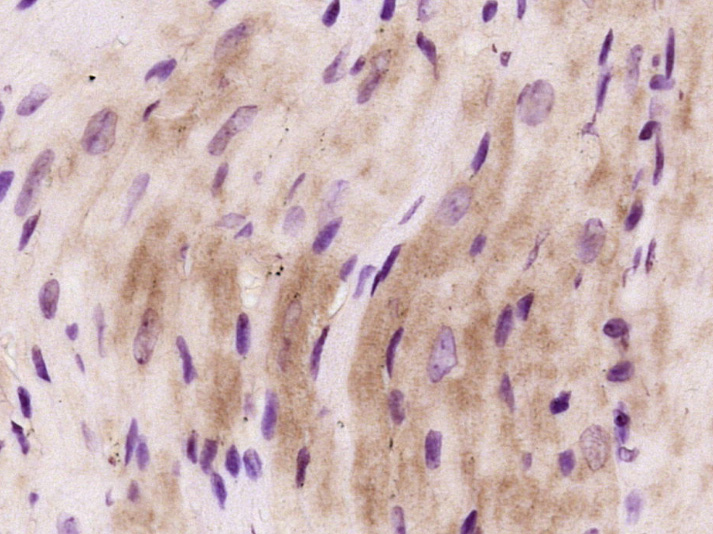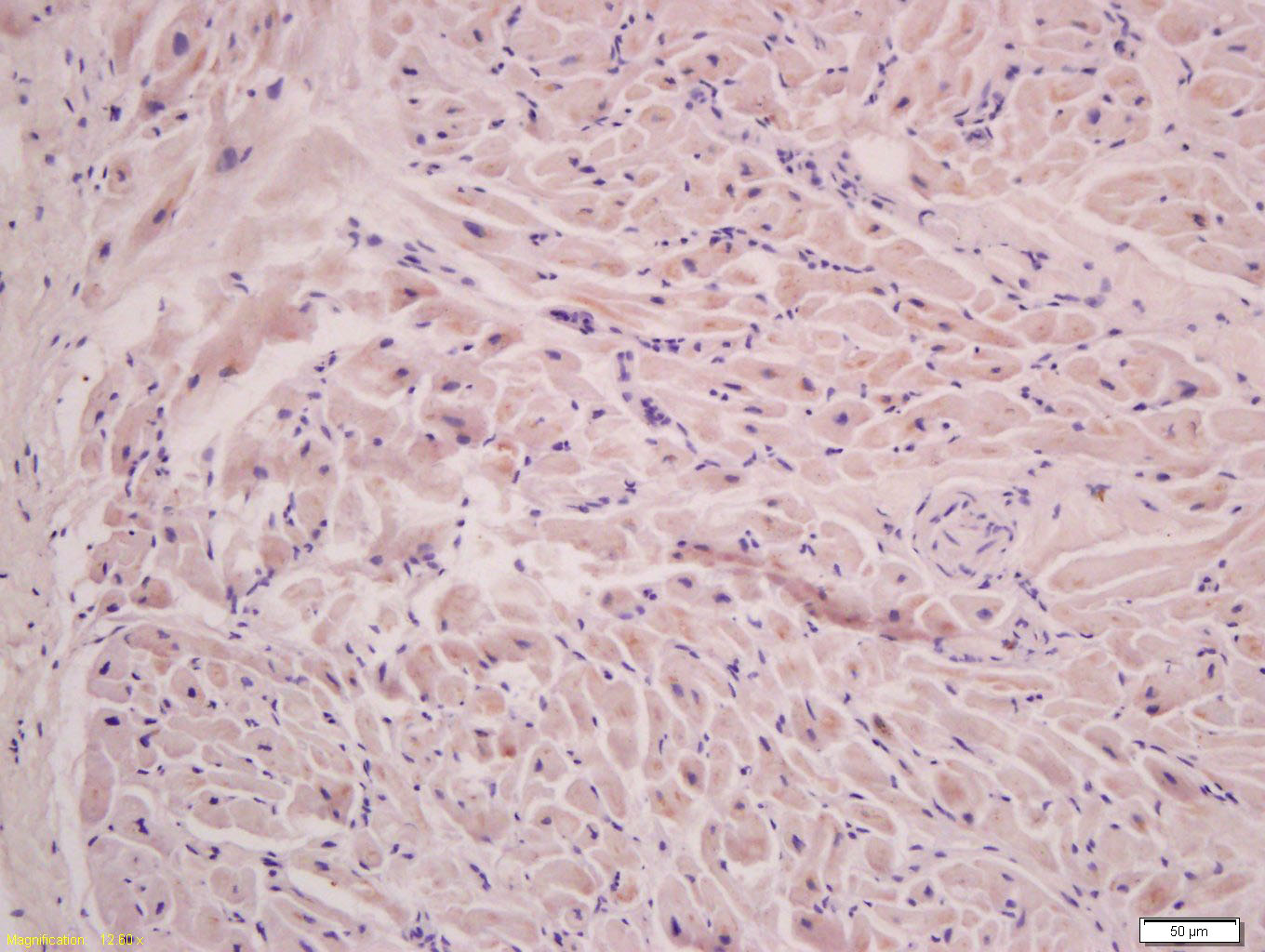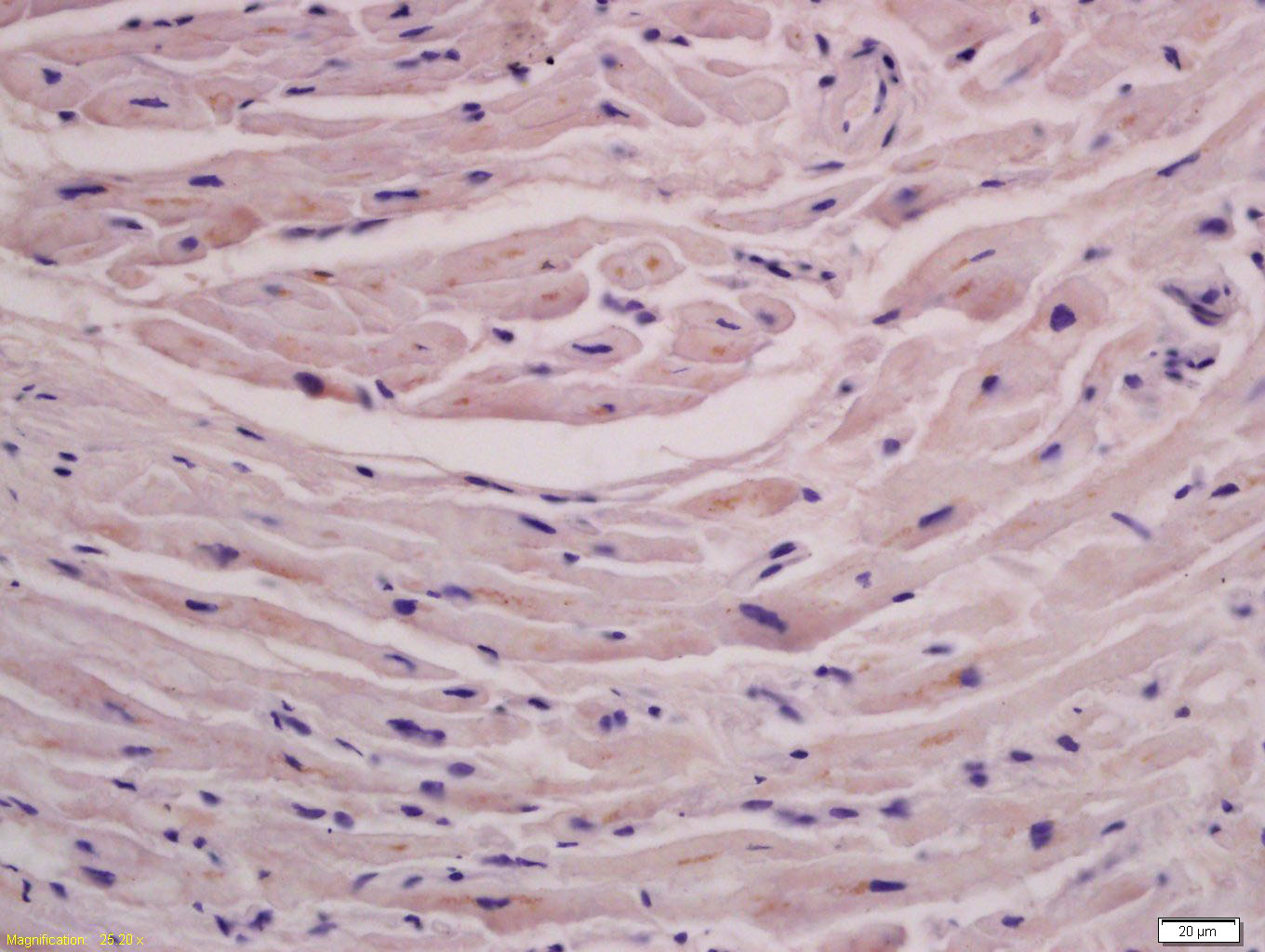
Rabbit Anti-FLNC antibody
ABP 280; ABP280; ABP L; ABPL; Actin binding like protein; Actin binding protein 280; Filamin 2; Filamin2; Filamin-2; Filamin C; Filamin C gamma; FLJ10186; FLN 2; FLN2; FLNC; Gamma actin binding protein; Gamma filamin; Protein FLNc; FLNC_HUMAN; Filamin-C;
View History [Clear]
Details
Product Name FLNC Chinese Name 细丝蛋白2抗体 Alias ABP 280; ABP280; ABP L; ABPL; Actin binding like protein; Actin binding protein 280; Filamin 2; Filamin2; Filamin-2; Filamin C; Filamin C gamma; FLJ10186; FLN 2; FLN2; FLNC; Gamma actin binding protein; Gamma filamin; Protein FLNc; FLNC_HUMAN; Filamin-C; FLN-C; ABP-280-like protein; ABP-L; Actin-binding-like protein. Research Area Cell biology Neurobiology Signal transduction Cytoskeleton The new supersedes the old Immunogen Species Rabbit Clonality Polyclonal React Species Human, Mouse, Rat, (predicted: Dog, Pig, Cow, Horse, Sheep, ) Applications WB=1:500-2000 ELISA=1:5000-10000 IHC-P=1:100-500 IHC-F=1:100-500 ICC=1:100-500 IF=1:100-500 (Paraffin sections need antigen repair)
not yet tested in other applications.
optimal dilutions/concentrations should be determined by the end user.Theoretical molecular weight 300kDa Cellular localization cytoplasmic The cell membrane Form Liquid Concentration 1mg/ml immunogen KLH conjugated synthetic peptide derived from human Filamin 2: 251-350/2725 Lsotype IgG Purification affinity purified by Protein A Buffer Solution 0.01M TBS(pH7.4) with 1% BSA, 0.03% Proclin300 and 50% Glycerol. Storage Shipped at 4℃. Store at -20 °C for one year. Avoid repeated freeze/thaw cycles. Attention This product as supplied is intended for research use only, not for use in human, therapeutic or diagnostic applications. PubMed PubMed Product Detail Filamins are Actin-binding proteins which contain an N-terminal Actin-binding domain, a membrane glycoprotein domain and a C-terminal self-association domain. Filamins help reshape the cytoskeleton by forming flexible cross-links between two Actin filaments, which maintain membrane integrity during force application. Filamins also participate in signal transduction pathways associated with cell motility, adhesion, differentiation and survival, and force transduction. The filamin family is comprised of Filamin 1, Filamin 2 and Filamin 3. Filamin 2, also designated Filamin C, is a skeletal- and cardiac-muscle specific form of Filamin, which binds ©-sarcoglycan and ∂-sarcoglycan, but not å-sarcoglycan or ∫-sarcoglycan. Muscular dystrophy, an inherited group of disorders resulting in progressive weakness of muscles in the body, is associated with irregular subcellular localization of Filamin 2 caused by a deficiency in KY, a protein that interacts with Filamin 2.
Function:
FLNC is a muscle-specific filamin, which plays a central role in muscle cells, probably by functioning as a large actin-cross-linking protein. May be involved in reorganizing the actin cytoskeleton in response to signaling events, and may also display structural functions at the Z-disks in muscle cells. Defects in FLNC are the cause of autosomal dominant filaminopathy. Myofibrillar myopathy (MFM) is a neuromuscular disorder, usually with an adult onset, characterized by focal myofibrillar destruction and pathological cytoplasmic protein aggregations. Autosomal dominant filaminopathy is a form of MFM characterized by morphological features of MFM and clinical features of a limb-girdle myopathy. A heterozygous nonsense mutation which segregates with the disease, has been identified in the FLNC gene.
Subunit:
Homodimer. Interacts with KY. Interacts with IGFN1. Interacts with FLNB, KCND2, ITGB1A, INPPL1, MYOT, MYOZ1 and MYOZ3. Interacts with sarcoglycans SGCD and SGCG. Interacts (via filament repeats 17-18, 20-21 and 24) with USP25 (isoform USP25m only). Interacts with FBLIM1.
Subcellular Location:
Cytoplasm. Membrane; Peripheral membrane protein. Cytoplasm, cytoskeleton. Cytoplasm, myofibril, sarcomere, Z line. Note=A small amount localizes at membranes. In striated muscle cells, it predominantly localizes in myofibrillar Z lines, while a minor fraction localizes with subsarcolemme.
Tissue Specificity:
Highly expressed in striated muscles. Weakly expressed in thyroid, fetal brain, fetal lung, retina, spinal cord and bone marrow. Not expressed in testis, pancreas, adrenal gland, placenta, liver and kidney.
Post-translational modifications:
Ubiquitinated by FBXL22, leading to proteasomal degradation.
DISEASE:
Defects in FLNC are the cause of myopathy myofibrillar type 5 (MFM5) [MIM:609524]. A neuromuscular disorder, usually with an adult onset, characterized by focal myofibrillar destruction and pathological cytoplasmic protein aggregations, and clinical features of a limb-girdle myopathy.
Defects in FLNC are the cause of myopathy distal type 4 (MPD4) [MIM:614065]. MPD4 is a slowly progressive muscular disorder characterized by distal muscle weakness and atrophy affecting the upper and lower limbs. Onset occurs around the third to fourth decades of life, and patients remain ambulatory even after long disease duration. Muscle biopsy shows non-specific changes with no evidence of rods, necrosis, or inflammation.
Similarity:
elongs to the filamin family.
Contains 1 actin-binding domain.
Contains 2 CH (calponin-homology) domains.
Contains 24 filamin repeats.
SWISS:
Q14315
Gene ID:
2318
Database links:Entrez Gene: 2318 Human
Entrez Gene: 68794 Mouse
SwissProt: Q14315 Human
SwissProt: Q8VHX6 Mouse
Unigene: 58414 Human
Unigene: 39046 Mouse
Unigene: 22352 Rat
Product Picture
Lane 1: Human U-2 OS cell lysates
Primary: Anti-FLNC (SL13182R) at 1/1000 dilution
Secondary: IRDye800CW Goat Anti-Rabbit IgG at 1/20000 dilution
Predicted band size: 300 kDa
Observed band size: 280 kDa
Paraformaldehyde-fixed, paraffin embedded (Mouse heart); Antigen retrieval by boiling in sodium citrate buffer (pH6.0) for 15min; Block endogenous peroxidase by 3% hydrogen peroxide for 20 minutes; Blocking buffer (normal goat serum) at 37°C for 30min; Antibody incubation with (FLNC) Polyclonal Antibody, Unconjugated (SL13182R) at 1:400 overnight at 4°C, followed by operating according to SP Kit(Rabbit) (sp-0023) instructionsand DAB staining.Tissue/cell: rat cardiac muscle; 4% Paraformaldehyde-fixed and paraffin-embedded;
Antigen retrieval: citrate buffer ( 0.01M, pH 6.0 ), Boiling bathing for 15min; Block endogenous peroxidase by 3% Hydrogen peroxide for 30min; Blocking buffer (normal goat serum,C-0005) at 37℃ for 20 min;
Incubation: Anti-FLNC Polyclonal Antibody, Unconjugated(SL13182R) 1:200, overnight at 4°C, followed by conjugation to the secondary antibody(SP-0023) and DAB(C-0010) staining
Tissue/cell: rat cardiac muscle; 4% Paraformaldehyde-fixed and paraffin-embedded;
Antigen retrieval: citrate buffer ( 0.01M, pH 6.0 ), Boiling bathing for 15min; Block endogenous peroxidase by 3% Hydrogen peroxide for 30min; Blocking buffer (normal goat serum,C-0005) at 37℃ for 20 min;
Incubation: Anti-FLNC Polyclonal Antibody, Unconjugated(SL13182R) 1:200, overnight at 4°C, followed by conjugation to the secondary antibody(SP-0023) and DAB(C-0010) staining
References (0)
No References
Bought notes(bought amounts latest0)
No one bought this product
User Comment(Total0User Comment Num)
- No comment






 +86 571 56623320
+86 571 56623320
 +86 18668110335
+86 18668110335

